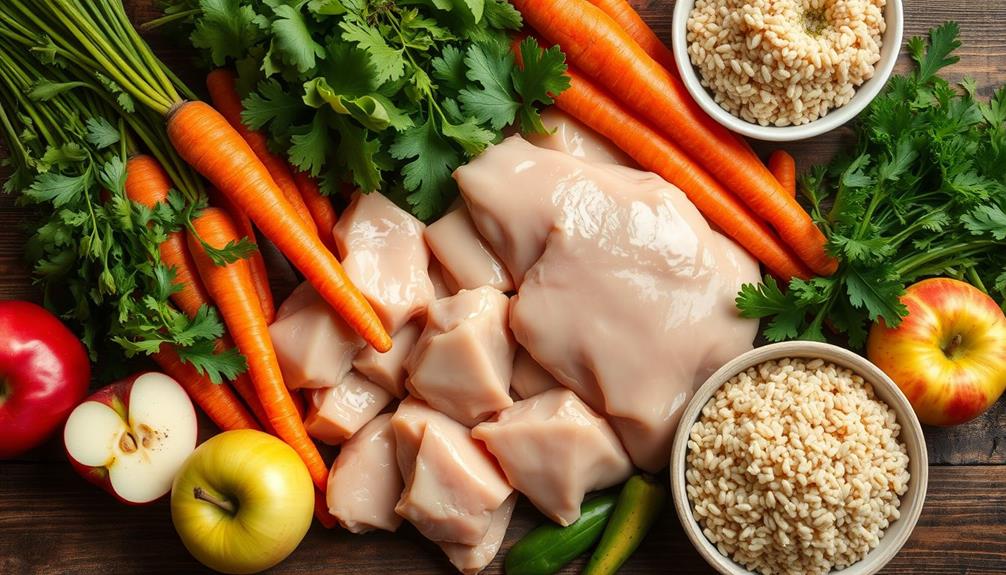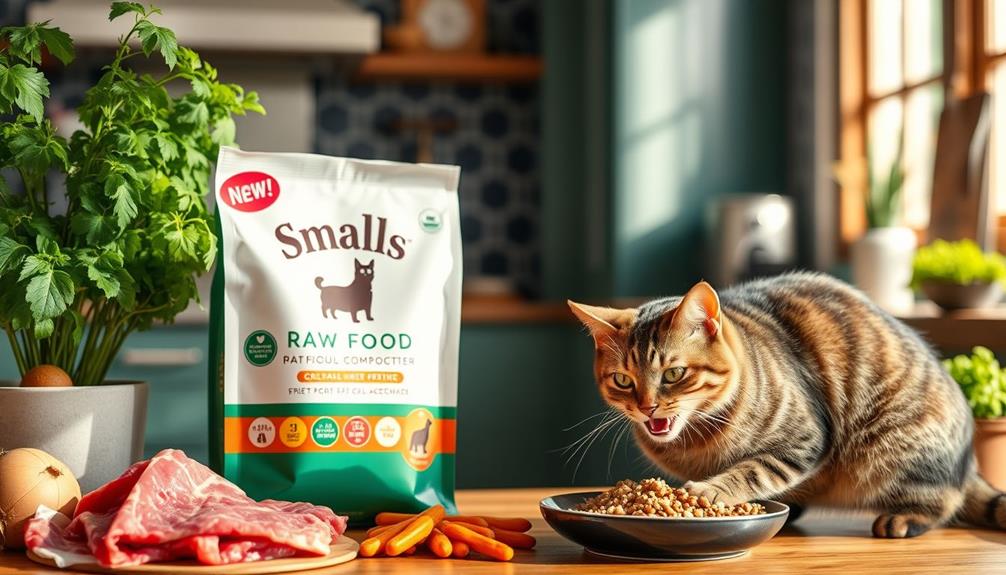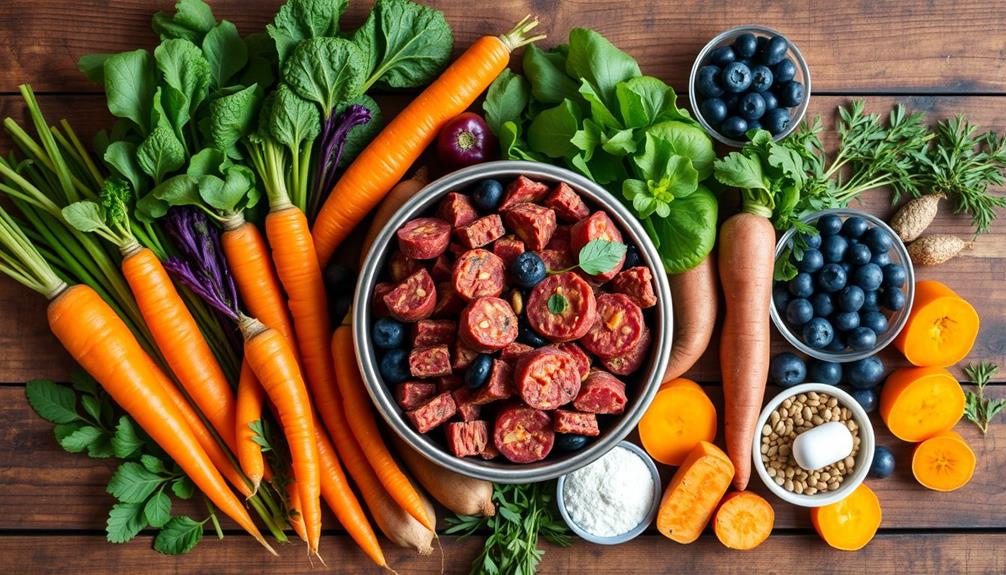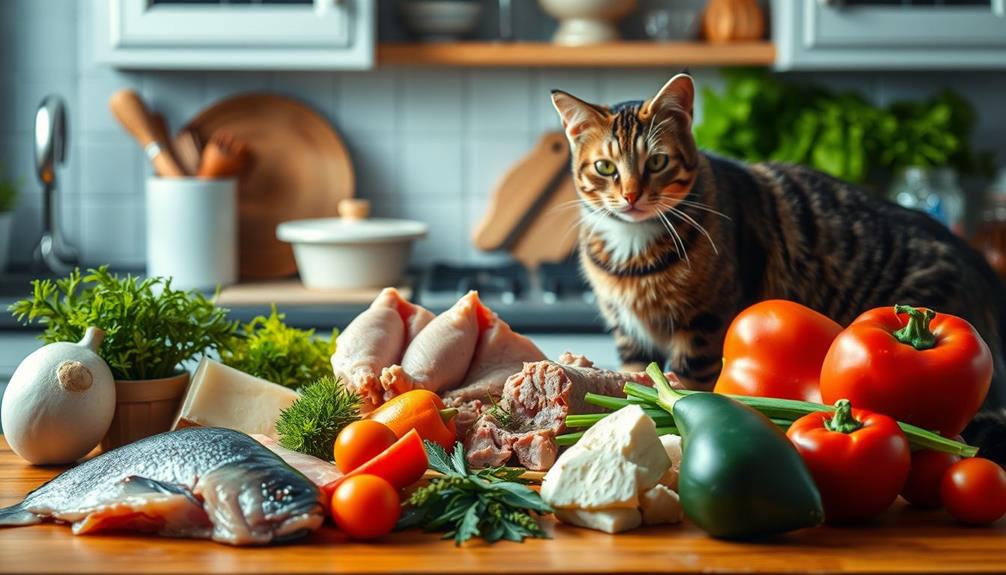Feeding your dog a raw food diet involves selecting the right ingredients for a balanced meal. Aim for 70% muscle meat, 10-15% raw bones, and 10-15% organ meats like liver for essential vitamins. Incorporating safe fruits and vegetables, such as carrots and blueberries, adds valuable nutrients. Remember to maintain hygiene by washing hands and surfaces after handling raw food. Shift your dog slowly over 7-10 days to avoid digestive issues. Monitor their health regularly and adjust portions based on their needs. Ready to explore more options and tips for a successful raw diet?
Key Takeaways
- Include 70% lean muscle meat, 10-15% raw bones, and 10-15% organ meats for a balanced diet.
- Incorporate safe fruits and vegetables like carrots and blueberries for added vitamins and antioxidants.
- Choose a variety of protein sources like chicken, beef, and fish to enhance nutrient diversity.
- Monitor your dog's health and adjust portions based on their weight and activity levels.
- Ensure all raw food is fresh and handle it safely to prevent contamination and bacterial growth.
Understanding Raw Dog Food
Understanding raw dog food is vital for any pet owner considering this diet for their furry friend. Raw dog food consists of uncooked ingredients like muscle meat, organ meats, and bones, closely aligning with dogs' natural dietary needs.
To create a balanced raw diet, aim for about 70% muscle meat, 10-15% raw bones, and 10-20% organ meats. This combination guarantees your dog receives essential nutrients such as calcium, vitamins, and minerals. Additionally, it's important to incorporate safe snacks for dogs to enhance their diet and provide variety in their meals, such as certain vegetables that are safe for canine consumption safe snacks for pets.
The BARF (Biologically Appropriate Raw Food) diet promotes feeding dogs as their wild ancestors would, encouraging a variety of foods to enhance nutritional value. Dogs possess a robust digestive system equipped with strong stomach acid and enzymes, enabling them to effectively digest raw food and handle bacteria that might pose risks to humans.
However, when feeding raw food, it's essential to follow safe handling practices. Always clean surfaces thoroughly and store food properly to minimize the risk of bacterial contamination.
Nutritional Benefits of Raw Diet
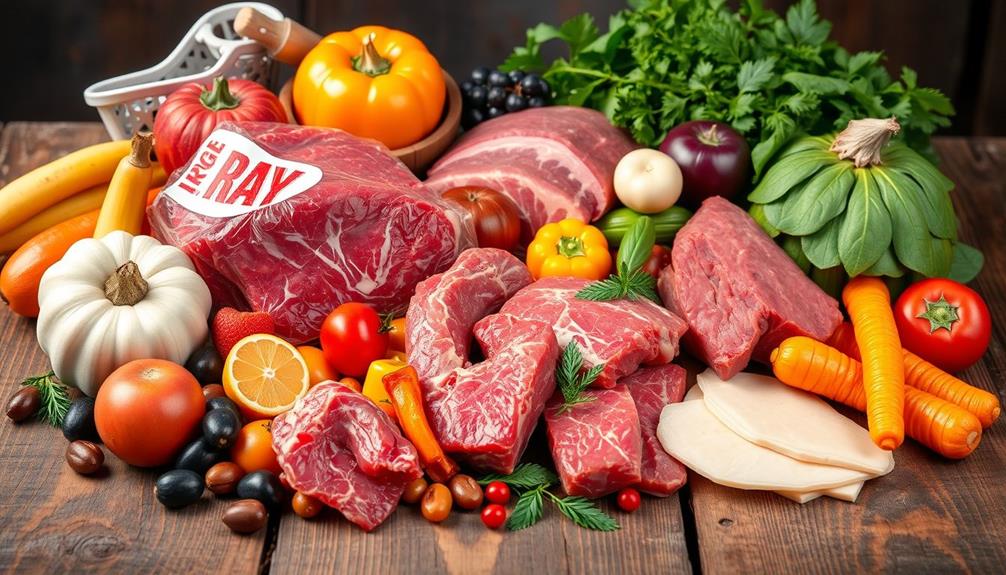
A raw diet for dogs offers numerous nutritional benefits that can substantially improve your pet's overall health. This type of diet is rich in natural, unprocessed ingredients, which promote better digestion and nutrient absorption. As a result, you're likely to notice smaller and firmer stools.
Additionally, incorporating fresh fruits and vegetables can provide essential vitamins and minerals, enhancing overall health and energy; antioxidants and vitamins found in these foods can contribute to a stronger immune system. Raw meat closely aligns with dogs' biological needs, providing essential amino acids and nutrients that reflect their ancestral diet; after all, dogs share 99.8% of their DNA with wolves.
Incorporating organ meats into your dog's raw diet is essential, as these are concentrated sources of important vitamins and minerals. For instance, liver should make up about 10% of the diet to guarantee your dog receives the necessary nutrients.
Unlike processed foods, raw diets are free from artificial additives, preservatives, and fillers, which supports overall health.
Moreover, the natural fats present in unprocessed ingredients can enhance your dog's skin and coat health, providing moisture and promoting a shiny appearance.
Essential Ingredients for Raw Feeding
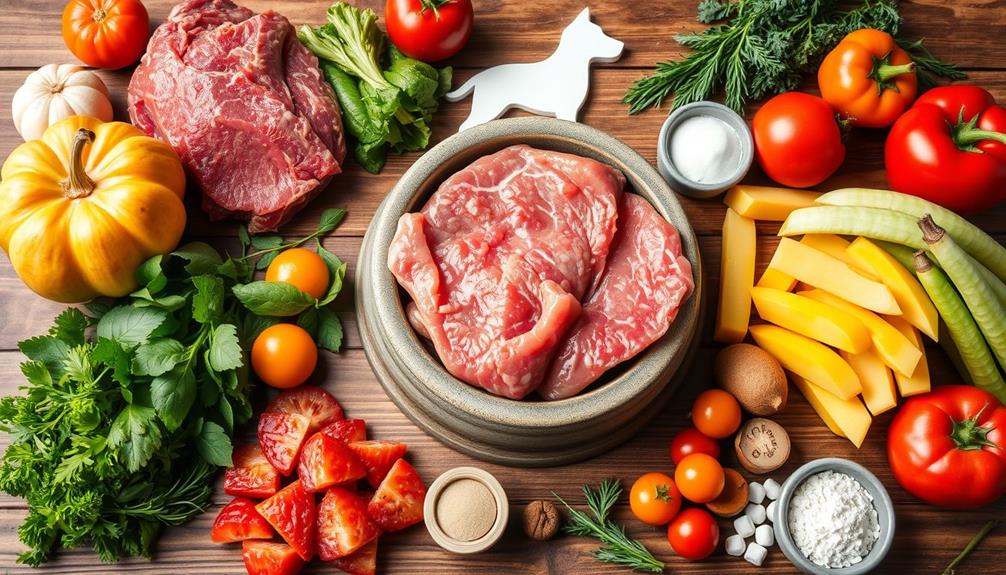
When you switch to a raw diet for your dog, achieving nutritional balance is key for their health and vitality.
It's crucial to select safe, high-quality ingredients that meet their dietary needs. Incorporating a variety of protein sources, such as meats and organs, can enhance the nutrient profile of your dog's meals.
Focusing on the right proportions and variety can help you create a well-rounded meal plan for your furry friend, ensuring they receive all the necessary vitamins and minerals for peak health.
Nutritional Balance Importance
Nutritional balance is fundamental for a successful raw feeding regimen for your dog. A nutritionally balanced raw dog food diet should include about 70% lean muscle meat, 10% raw bone, 10% organ meats (5% liver and 5% other secreting organs), and 10-20% vegetables or fruits. This combination provides diverse protein sources, which are essential for meeting your dog's dietary needs.
Additionally, incorporating healthy dog snacks can enhance your pet's overall wellness and satisfaction, keeping them engaged with varied flavors and textures healthy dog snacks.
Including a variety of protein sources like chicken, beef, lamb, and fish guarantees a broader nutrient profile. It's also important to maintain a fat content of 10% to 20%, as fats support energy levels and promote healthy skin and coat condition.
To meet your dog's requirements for calcium and minerals, incorporate raw bones, which should account for 10% to 15% of their total food intake.
Keep in mind that monitoring and adjusting the diet is critical. Regularly assess your dog's health, activity level, and any specific dietary needs to prevent deficiencies.
Safe Ingredient Selection
Selecting safe ingredients is key to guaranteeing your dog thrives on a raw feeding diet. A balanced raw dog food diet should consist of 70-80% muscle meat, 10-15% raw bones, and 10-15% organ meats to provide essential nutrients.
When choosing organ meats, include liver (5-10% of the diet) and other secreting organs (up to 5%) for crucial vitamins and minerals. It's also important to take into account the nutritional impact of the ingredients you choose, as certain foods can provide additional benefits such as foods beneficial for managing gout symptoms when incorporated thoughtfully.
To create a nutritious meal, think about incorporating healthy fats, which should make up 10-20% of the diet. These can come from oils or fatty fish, promoting skin health and overall vitality.
Additionally, safe vegetables and fruits should constitute 10-20% of the diet. Here are some excellent options:
- Carrots
- Blueberries
- Sweet potatoes
Always be cautious about toxic ingredients. Avoid grapes, onions, and chocolate, as these can harm your dog.
Guarantee all food is fresh and free from additives or preservatives. By focusing on safe ingredient selection, you can create a balanced diet that supports your dog's health and well-being.
Safe Practices for Raw Food Handling
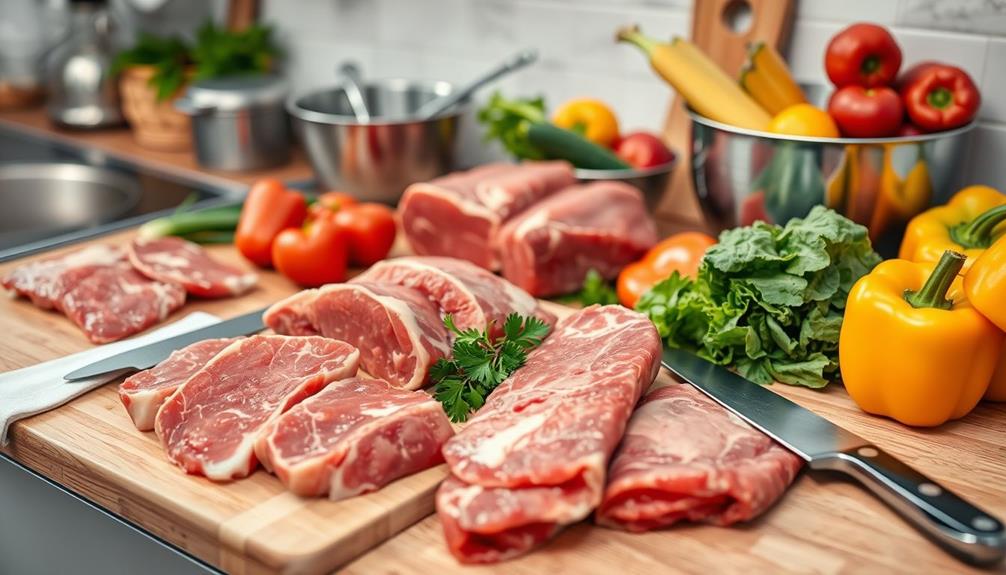
Handling raw food for dogs requires careful attention to safety practices to prevent contamination. Start by washing your hands and clean surfaces thoroughly with hot, soapy water before and after raw food handling. This is essential in maintaining food safety.
Always use separate cutting boards and utensils for raw dog food and human food to avoid cross-contamination. To enhance your cleaning routine, consider investing in a powerful vacuum like those recommended for superior dust removal, as this can help keep your pet's environment clean and allergen-free.
To guarantee the raw meat you feed your dog is safe, freeze it for at least three days before thawing raw food. This process eliminates potential parasites and harmful bacteria while preserving important nutrients.
When you're ready to use the raw dog food, store it in airtight containers in the refrigerator. Remember to use it within 1-2 days of thawing to maintain freshness and safety.
It's also significant to regularly check your refrigerator's temperature, keeping it below 40°F (4°C) to inhibit bacterial growth in raw food.
Transitioning to a Raw Diet
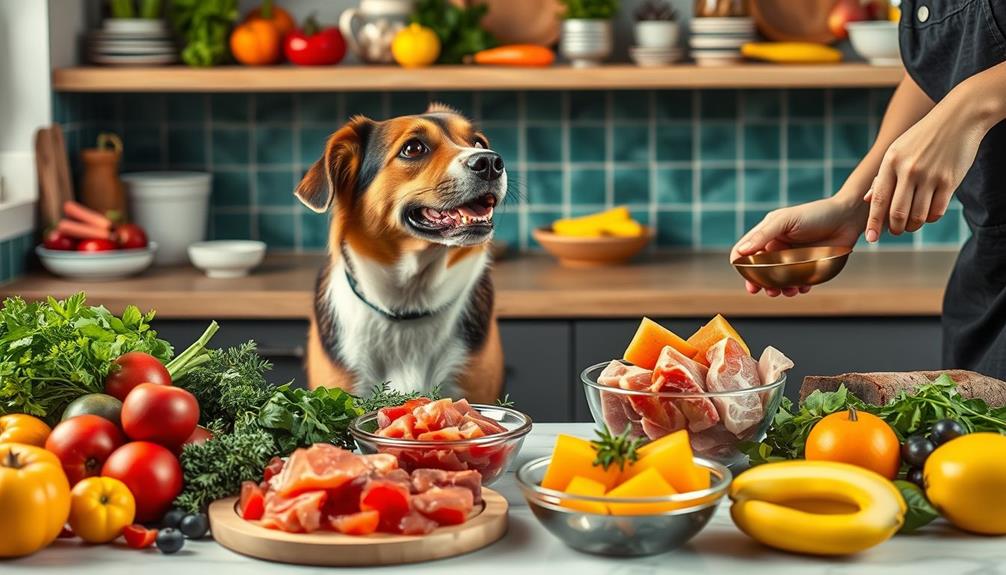
Shifting your dog to a raw diet involves a careful process that typically spans 7 to 10 days.
It's important to guarantee that the raw food you choose is balanced and includes a variety of proteins and nutrients, as this can greatly impact your dog's health.
You'll start by mixing 20% raw food with 80% of their current diet, gradually increasing the raw portion while monitoring any health changes.
For guidance on budgeting for your dog's dietary needs, consider creating a personal budget to manage expenses effectively.
Adjustments may be necessary based on your dog's reactions, so staying attentive is key.
Transition Process Steps
When introducing your dog to a raw diet, it's essential to do so gradually to guarantee a smooth shift. Start by mixing 20% raw food with 80% of their current diet for the first three days.
Essential oils, such as eucalyptus oil, can also support respiratory health for dogs during this changeover. Over the next few days, gradually increase the raw food proportion as follows:
- Days 4-6: 40% raw, 60% current food
- Days 7-9: 60% raw, 40% current food
- Days 10-12: 80% raw, 20% current food
By day 12 or later, you should aim for a 100% raw food diet.
Make sure to monitor your dog's weight and overall health throughout the adjustment process. Adjust the feeding amounts based on their activity level to meet their nutritional needs effectively.
This gradual introduction not only helps your dog adapt but also allows you to observe any potential digestive issues.
If your dog shows signs of discomfort or if you have concerns, don't hesitate to consult with a veterinarian.
Monitoring Health Changes
Monitoring your dog's health during the shift to a raw diet is essential for guaranteeing a successful change. Start by regularly monitoring health changes, focusing on weight management and body condition.
Additionally, understanding the nutritional adequacy of the raw diet is critical for your dog's overall health, especially as you move to this new feeding approach. Adjust food portions based on your dog's individual needs and activity levels to maintain a healthy weight. Keeping a food journal can help you track dietary changes and observe health changes, like improvements in coat condition, digestion, or energy levels.
Be vigilant for signs of digestive upset, such as diarrhea or vomiting, particularly during the initial adjustment phase. If you notice any issues, consider modifying the diet gradually to reduce these problems.
Consulting with a veterinarian is important to assess your dog's health status and guarantee that any observed changes are beneficial and within a healthy range. For additional support in managing dietary changes, consider exploring resources on nutritional guidance for pets.
Conduct regular check-ups every few weeks to monitor your dog's overall health and nutritional adequacy as they adapt to their new raw diet. This proactive approach will help you identify any potential concerns early and make necessary adjustments, guaranteeing your dog thrives on their new dietary path.
Gradual Diet Adjustments
Introducing your dog to a raw diet requires a careful and gradual approach to guarantee a smooth alteration. Start the adjustment period by mixing 20% raw dog food with 80% of their current food for the first three days. This gradual modification is important as it helps in managing potential digestive issues, which can be vital for dogs with pre-existing health conditions or emotional sensitivities, similar to those seen in individuals with BPD dynamics in relationships.
Over the next week, gradually adjust the ratio to 40/60 raw food by days 4-6, then 60/40 by days 7-9, aiming for 100% raw food by day 12.
During this process, keep an eye on your dog's weight and health. Some dogs, especially those with health issues or older dogs, may require more time to adjust.
Here are some essential tips for a successful adjustment:
- Use a food journal to track changes in behavior, digestion, and overall health.
- Be patient and flexible; every dog responds differently to a raw diet.
- Monitor health closely, adjusting the pace of the diet adjustment if needed.
Daily Feeding Guidelines
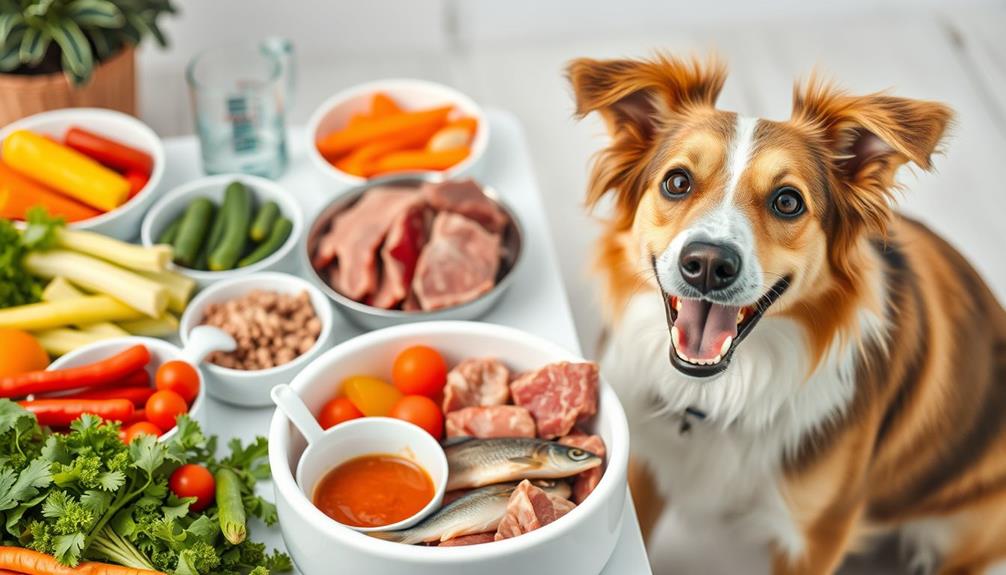
Feeding your dog a raw food diet involves carefully balancing the amount based on their ideal body weight, activity level, and age. Daily feeding guidelines suggest giving 2-5% of your dog's ideal body weight in raw food. For active or younger dogs, lean towards the higher percentage, while senior or less active dogs may need less.
It's important to monitor your dog's health closely, just as early detection is vital in mammography aims to detect breast cancer early for better treatment outcomes.
When shifting to raw food, start with a mix of 20% raw and 80% of their current food for the first three days, gradually increasing the raw portion until you reach 100% by Day 12.
During this process, it's vital to monitor the dog's weight and health, adjusting portion sizes according to their activity level and overall condition.
To guarantee a balanced diet, utilize online raw food calculators to determine personalized feeding amounts based on your dog's age, weight, and activity level.
Cost-Effective Raw Feeding Tips
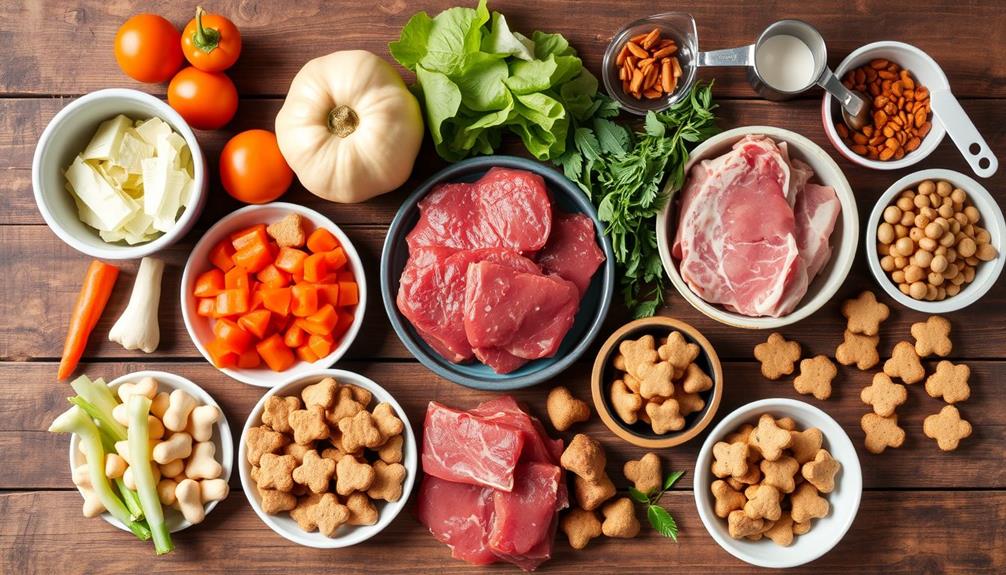
Adjusting to a raw food diet can be beneficial for your dog's health, but it doesn't have to break the bank. Here are some cost-effective tips to help you with raw feeding while guaranteeing your pup gets a balanced raw diet:
- Buy raw ingredients in bulk and freeze them in portions. This not only cuts costs but also saves time during meal preparation.
- Build a relationship with a local butcher. They often provide cheaper cuts of meat, raw bones, and offal, which are excellent for your dog's diet.
- Make meals at home using whole ingredients; it's generally more affordable than commercial raw diets.
Don't forget to simplify your meal prep. Shaping meat into balls or patties can make portioning easier and more consistent.
Additionally, utilize online raw food calculators to determine the right amounts to buy based on your dog's dietary requirements.
Frequently Asked Questions
What Kind of Raw Food Is Good for Dogs?
When choosing raw food for your dog, focus on lean meats, raw bones, and organ meats. Add some blended vegetables or fruits for nutrients, and always guarantee the ingredients are fresh and high-quality.
What Should I Give My Dog With Raw Food?
When it comes to feeding your dog raw food, think of it as a gourmet experience. You'll want to include muscle meat, raw bones, organ meats, and a splash of fruits and veggies for balance.
How Do I Make Sure Raw Food Is Safe for My Dog?
To guarantee raw food's safe for your dog, source it from reputable suppliers, practice safe handling, freeze it for 48 hours, store in airtight containers, and monitor your dog's health closely during the changeover.
What Is the Next Best Thing to Raw Dog Food?
If raw food's a culinary paradise for your pup, then fresh, high-quality dog food—packed with human-grade ingredients—is its delightful cousin. You'll find tailored meal plans and wholesome nutrients, making tails wag with joy!
Conclusion
In summary, feeding your dog a raw diet can be a game-changer for their health and well-being. By understanding the essentials and practicing safe handling, you're setting your furry friend up for success. Shifting might take time, but with patience and the right approach, you'll both reap the rewards. Remember, a happy dog is like a wagging tail—full of life and love! So immerse yourself, and watch your pup thrive with each meal.

